A Novel Method for Interferometric Phase Estimation in Dual-Channel Cancellation
Abstract
1. Introduction
2. Materials and Methods
2.1. Signal Model of the Dual Channel Cancellation
2.2. Estimation of the Interferometric Phase of the Source of Radiation
2.3. Effects of Co-Registration
2.4. Ghost Images
2.5. Dark Strap
2.6. Complexity Analysis
3. Experimental Studies
4. Discussion
5. Conclusions
Author Contributions
Funding
Institutional Review Board Statement
Informed Consent Statement
Data Availability Statement
Acknowledgments
Conflicts of Interest
Abbreviations
| Abbreviation | Full Name |
| HRWS | High-resolution and wide-swath |
| DCC | Dual-channel cancellation |
| JSR | Jamming-to-signal-ratio |
| SAR | Synthetic aperture radar |
| InSAR | Interferometric SAR |
| IPSR | Interferometric phase of the source of radiation |
| IPDC | Interferometric phase of the dual channels |
| PRT | Pulse repeat time |
| CS | Chirp Scaling |
| FFT | Fast Fourier transform |
| IFFT | Inverse fast Fourier transform |
| PRF | Pulse repeat frequency |
| NESZ | Noise equivalent sigma zero |
References
- Huang, L.; Dong, C.; Shen, Z.; Zhao, G. The Influence of Rebound Jamming on SAR GMTI. IEEE Geosci. Remote Sens. Lett. 2015, 12, 399–403. [Google Scholar] [CrossRef]
- Huang, Z.; Liu, A.; Xia, X.; Xu, H.; Wu, G. Azimuth Relocation for Multichannel SAR Ground Moving Targets via Noncoregistrated Inteferometry. IEEE Geosci. Remote Sens. Lett. 2020, 18, 652–656. [Google Scholar] [CrossRef]
- Tan, W.; Xu, W.; Huang, P.; Huang, Z.; Qi, Y.; Han, K. Investigation of Azimuth Multichannel Reconstruction for Moving Targets in High Resolution Wide Swath SAR. Sensors 2017, 17, 1270. [Google Scholar] [CrossRef] [PubMed]
- Wang, C.; Liao, G.; Zhang, Q. First Spaceborne SAR-GMTI Experimental Results for the Chinese Gaofen-3 Dual-Channel SAR Sensor. Sensors 2017, 17, 2683. [Google Scholar] [CrossRef] [PubMed]
- Wang, L.; Li, Y.; Wang, W.; An, D. Moving Target Indication for Dual-Channel Circular SAR/GMTI Systems. Sensors 2020, 20, 158. [Google Scholar] [CrossRef] [PubMed]
- Xu, J.; Huang, Z.; Yan, L.; Zhou, X.; Zhang, F.; Long, T. SAR Ground Moving Target Indication Based on Relative Residue of DPCA Processing. Sensors 2016, 16, 1676. [Google Scholar] [CrossRef] [PubMed]
- Giese, C.; Ulrich, D. The TanDEM-X space segment. In Proceedings of the 2011 IEEE International Geoscience and Remote Sensing Symposium, Vancouver, BC, Canada, 24–29 July 2011. [Google Scholar] [CrossRef]
- Lachaise, M.; Bachmann, M.; Schweisshelm, B.; Fritz, T. The Tandem-X Change Dem: Status of the Change Raw Dems Production. In Proceedings of the 2021 IEEE International Geoscience and Remote Sensing Symposium IGARSS, Brussels, Belgium, 11–16 July 2021. [Google Scholar] [CrossRef]
- Xu, H.; Li, S.; You, Y.; Liu, A.; Liu, W. Unwrapped Phase Estimation via Normalized Probability Density Function for Multibaseline InSAR. IEEE Access 2018, 7, 4979–4988. [Google Scholar] [CrossRef]
- Tian, T.; Zhou, F.; Zhao, B. Multi-receiver deception jamming against synthetic aperture radar. In Proceedings of the 2016 CIE International Conference on Radar (RADAR), Guangzhou, China, 10–13 October 2016. [Google Scholar] [CrossRef]
- Liu, Y.; Bu, Y.; Liu, H.; Wang, R. SAR Seeker Deception Jamming and Anti-jamming Measures. In Proceedings of the 2019 6th Asia-Pacific Conference on Synthetic Aperture Radar (APSAR), Xiamen, China, 26–29 November 2019. [Google Scholar] [CrossRef]
- Liu, H.; Li, D. RFI Suppression Based on Sparse Frequency Estimation for SAR Imaging. IEEE Geosci. Remote Sens. Lett. 2016, 13, 63–67. [Google Scholar] [CrossRef]
- Yang, Z.; Du, W.; Liu, Z.; Liao, G. WBI Suppression for SAR Using Iterative Adaptive Method. IEEE J. Sel. Top. Appl. Earth Obs. Remote Sens. 2016, 9, 1008–1014. [Google Scholar] [CrossRef]
- Yu, C.; Ma, X.; Zhang, Y.; Dong, Z.; Liang, D. Multichannel SAR ECCM based on Fast-time STAP and Pulse diversity. In Proceedings of the 2011 IEEE International Geoscience and Remote Sensing Symposium, Vancouver, BC, Canada, 24–29 July 2011. [Google Scholar]
- Liu, Z.; Zhang, Q.; Li, K. An Anti-Jamming Method against Two-Dimensional Deception Jamming by Spatial Location Feature Recognition. Sensors 2021, 21, 7702. [Google Scholar] [CrossRef] [PubMed]
- Liu, Y.; Zhang, Q.; Liu, Z.; Li, G.; Xiong, S.; Luo, Y. An Anti-Jamming Method against Interrupted Sampling Repeater Jamming Based on Compressed Sensing. Sensors 2022, 22, 2239. [Google Scholar] [CrossRef] [PubMed]
- Qiu, X.; Wang, P.; Jiang, J.; Li, X.; Tang, Z.; Wang, S. Research on SAR Anti-jamming Technique Based on Orthogonal LFM-PC Signals with Adaptive Initial Phase. In Proceedings of the 2021 2nd China International SAR Symposium (CISS), Shanghai, China, 3–5 November 2021. [Google Scholar] [CrossRef]
- Qiu, X.; Zhang, T.; Li, S.; Yuan, T.; Wang, F. SAR Anti-Jamming Technique Using Orthogonal LFM-PC Hybrid Modulated Signal. In Proceedings of the 2018 China International SAR Symposium (CISS), Shanghai, China, 10–12 October 2018. [Google Scholar] [CrossRef]
- Xin, J.; Bin, Y.C.; Dong, Q.W.; Hai, G.Z. Anti-jamming property of converse beam cross sliding spotlight SAR. In Proceedings of the 2009 2nd Asian-Pacific Conference on Synthetic Aperture Radar, Xi’an, China, 26–30 October 2009. [Google Scholar] [CrossRef]
- Zhao, J.; Zhang, Q.; Zhang, X.; He, H.; Zhou, T.; Zheng, J. Evaluation of the anti-jamming performance of SAR based on ELECTRE-III. In Proceedings of the 2021 IEEE International Conference on Advances in Electrical Engineering and Computer Applications (AEECA), Dalian, China, 27–28 August 2021. [Google Scholar] [CrossRef]
- Zhou, M.; Wang, Q.; He, F.; Meng, J. Impacts of Phase Noise on the Anti-Jamming Performance of Power Inversion Algorithm. Sensors 2022, 22, 2362. [Google Scholar] [CrossRef] [PubMed]
- Qin, J.; Yang, J.; He, Z.; Cai, C. Analysis of Target Loss Due to Suppressing SAR Jamming Using Dual-channel Cancellation. In Proceedings of the 2006 CIE International Conference on Radar, Shanghai, China, 16–19 October 2006. [Google Scholar] [CrossRef]
- Wang, W.; Wu, J.; Pei, J.; Sun, Z.; Yang, J. Anti-Deceptive Jamming of Jammer on the Coast for Multistatic SAR. In Proceedings of the 2021 IEEE International Geoscience and Remote Sensing Symposium IGARSS, Brussels, Belgium, 11–16 July 2021. [Google Scholar] [CrossRef]
- Ji, P.; Xing, S. An Anti-Jamming Method Against SAR Stationary Deceptive Targets Based on DPCA Processing. In Proceedings of the 2019 IEEE 4th International Conference on Signal and Image Processing (ICSIP), Wuxi, China, 19–21 July 2019. [Google Scholar] [CrossRef]
- Kong, Z.; Li, P.; Yan, X.; Hao, X. Anti-Sweep Jamming Design and Implementation Using Multi-Channel Harmonic Timing Sequence Detection for Short-Range FMCW Proximity Sensors. Sensors 2017, 17, 2042. [Google Scholar] [CrossRef] [PubMed]
- Wang, R.; Chen, J.; Wang, X.; Sun, B. High-Performance Anti-Retransmission Deception Jamming Utilizing Range Direction Multiple Input and Multiple Output (MIMO) Synthetic Aperture Radar (SAR). Sensors 2017, 17, 123. [Google Scholar] [CrossRef] [PubMed]
- Wang, R.; Sun, B.; Yi, C.; Chen, J.; Zhou, Y. Multi-Channnel and Mimo Sar Anti-Jamming Analysis. In Proceedings of the 2018 IEEE International Geoscience and Remote Sensing Symposium, Valencia, Spain, 22–27 July 2018. [Google Scholar] [CrossRef]
- Sun, B.; Li, J. A New Interference Elimination Method for Multi-Satellite SAR System. In Proceedings of the 2008 IEEE International Geoscience and Remote Sensing Symposium, Boston, MA, USA, 7–11 July 2008. [Google Scholar] [CrossRef]
- Wang, W.; Wu, J.; Li, Y.; Pei, J.; Yang, J.; Liang, C. A Novel Anti-Deceptive Jamming Method for Multistatic SAR. In Proceedings of the 2019 IEEE International Geoscience and Remote Sensing Symposium, Yokohama, Japan, 28 July–2 August 2019. [Google Scholar] [CrossRef]
- Ma, Y. Research on SAR Countermeasure Techniques; UEST of China: Chengdu, China, 2004. [Google Scholar]
- Ma, X.; Qin, J.; He, Z.; Yang, J.; Lu, Q. Three-Channel Cancellation of SAR Blanketing Jamming Suppression. Acta Electron. Sin. 2007, 35, 1015–1020. [Google Scholar] [CrossRef]
- Huang, L.; Dong, C.; Shen, Z.; Zhao, G. Investigation on Countermeasure against InSAR Dual-Channel Cancellation Technique with Multi-antenna Jamming. J. Electron. Inf. Technol. 2015, 37, 913–918. [Google Scholar]
- Liu, A.; Wang, F.; Xu, H.; Li, L. N-SAR: A New Multichannel Multimode Polarimetric Airborne SAR. IEEE J. Sel. Top. Appl. Earth Obs. Remote Sens. 2018, 11, 3155–3166. [Google Scholar] [CrossRef]
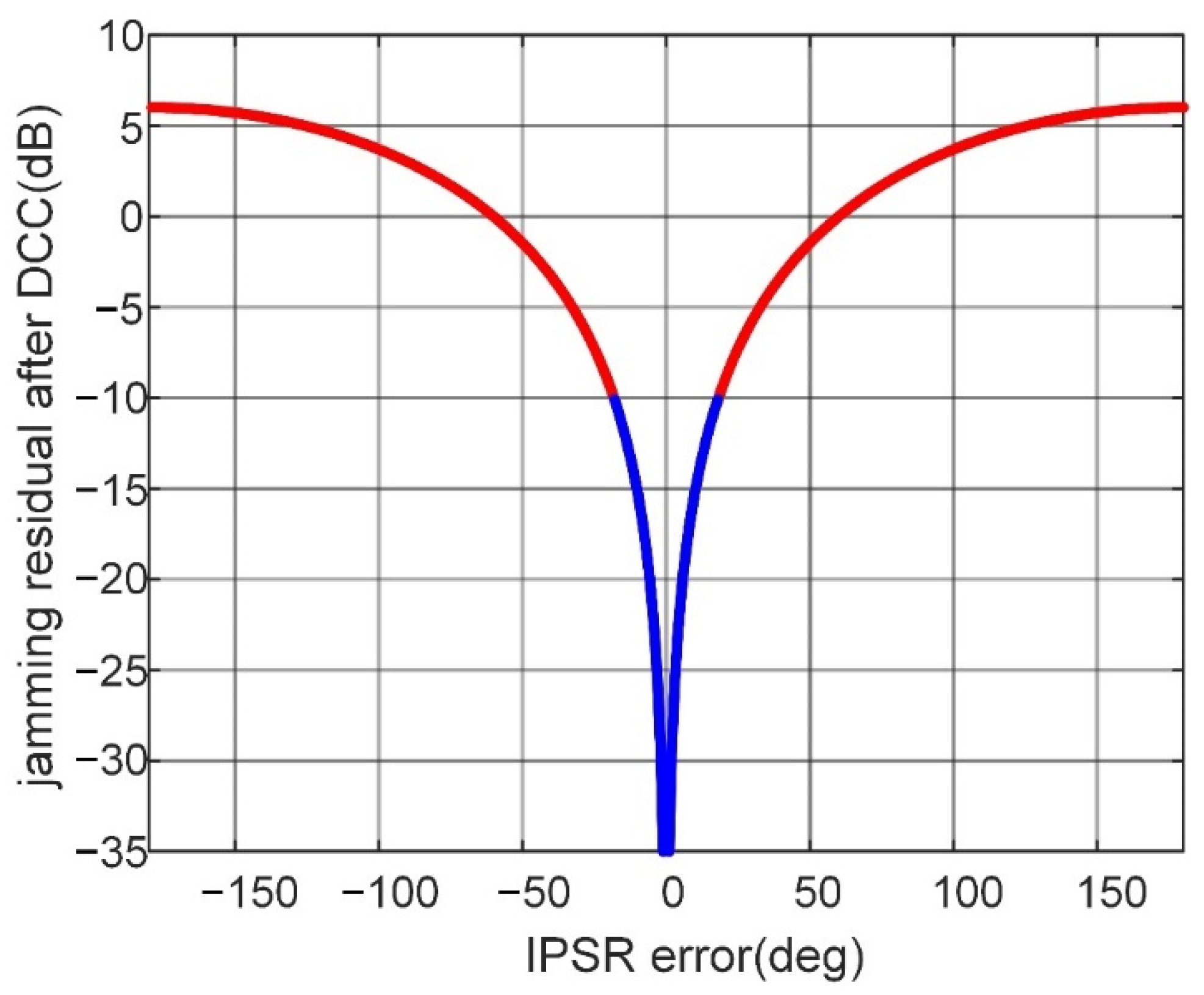
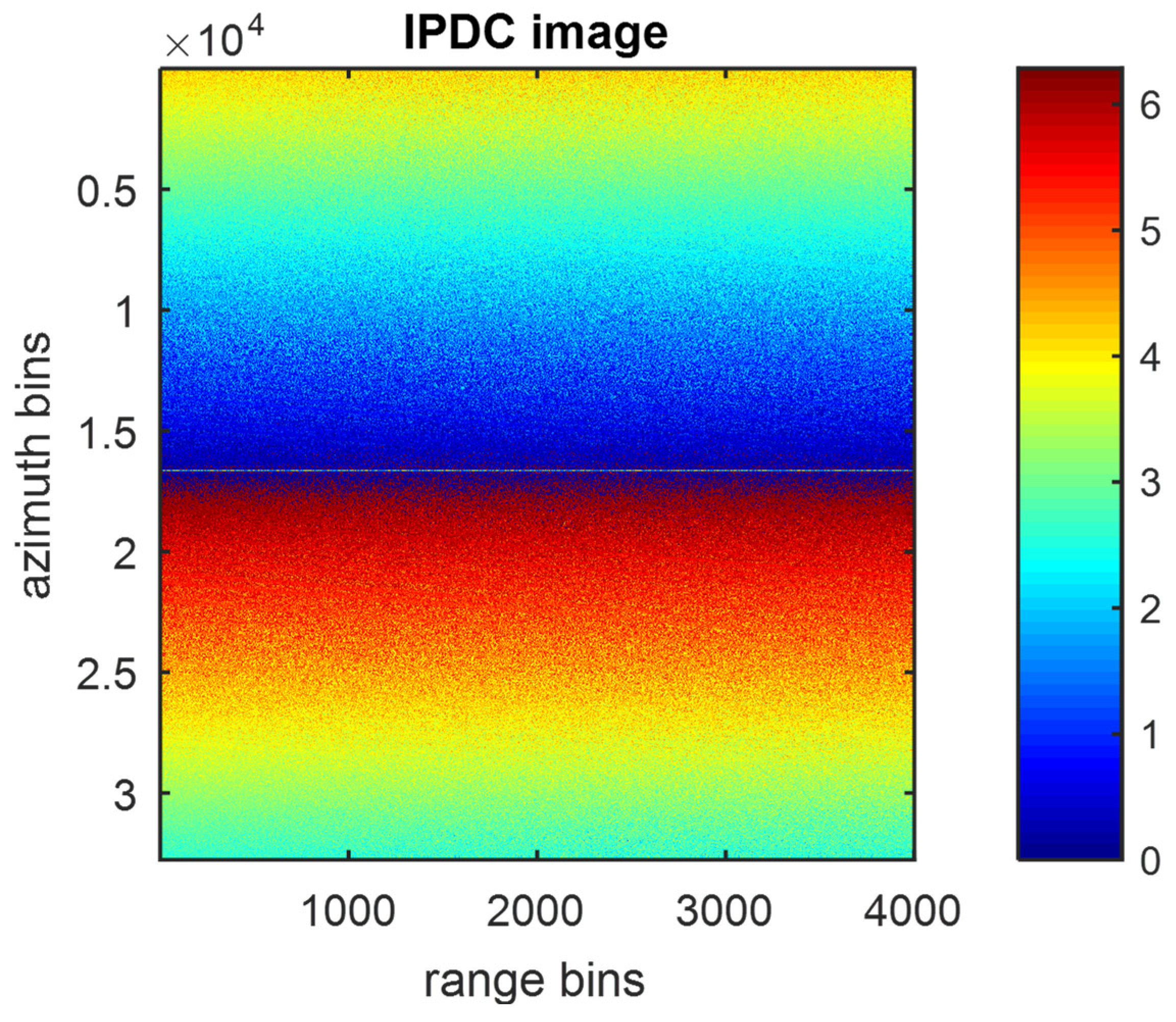
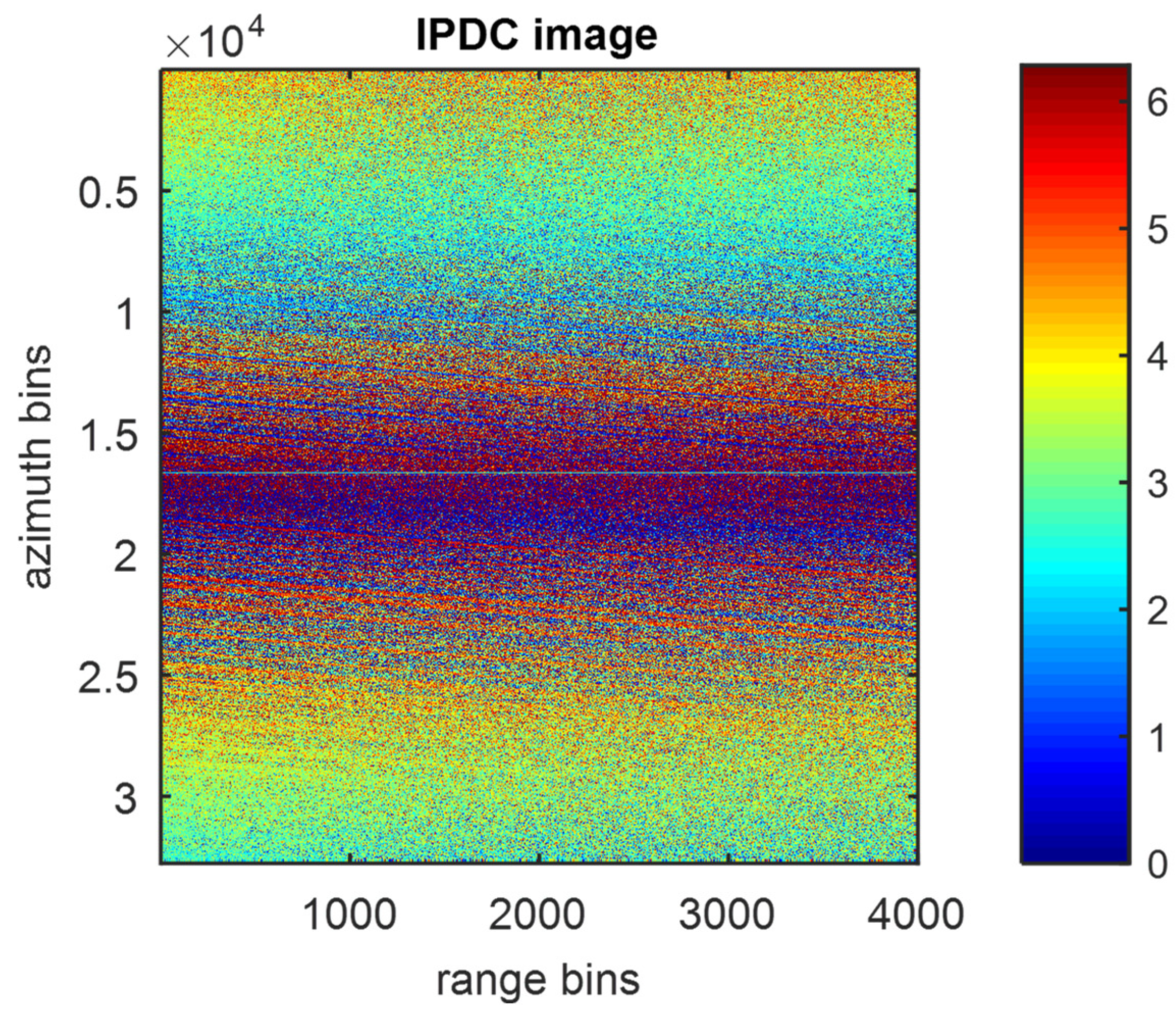

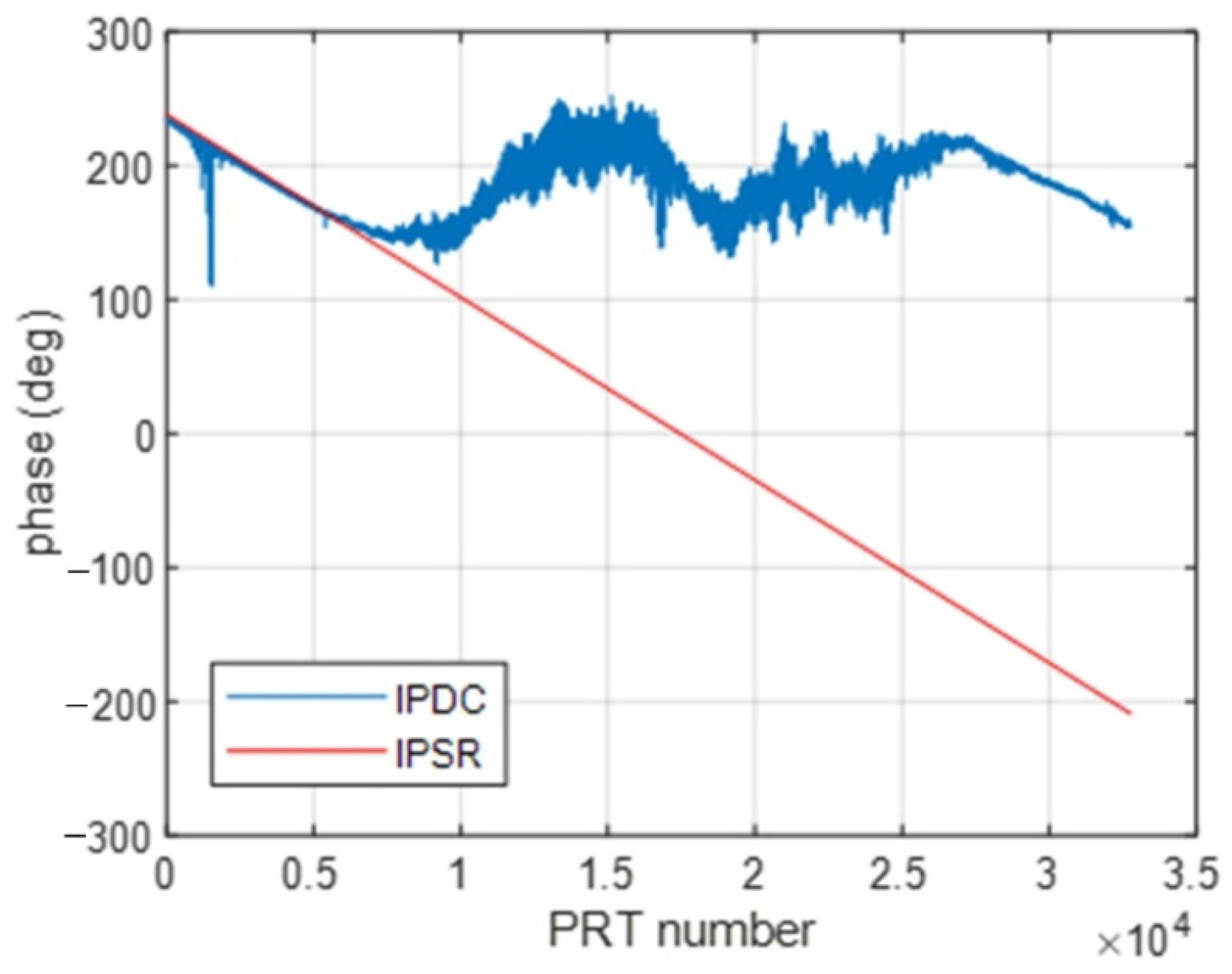
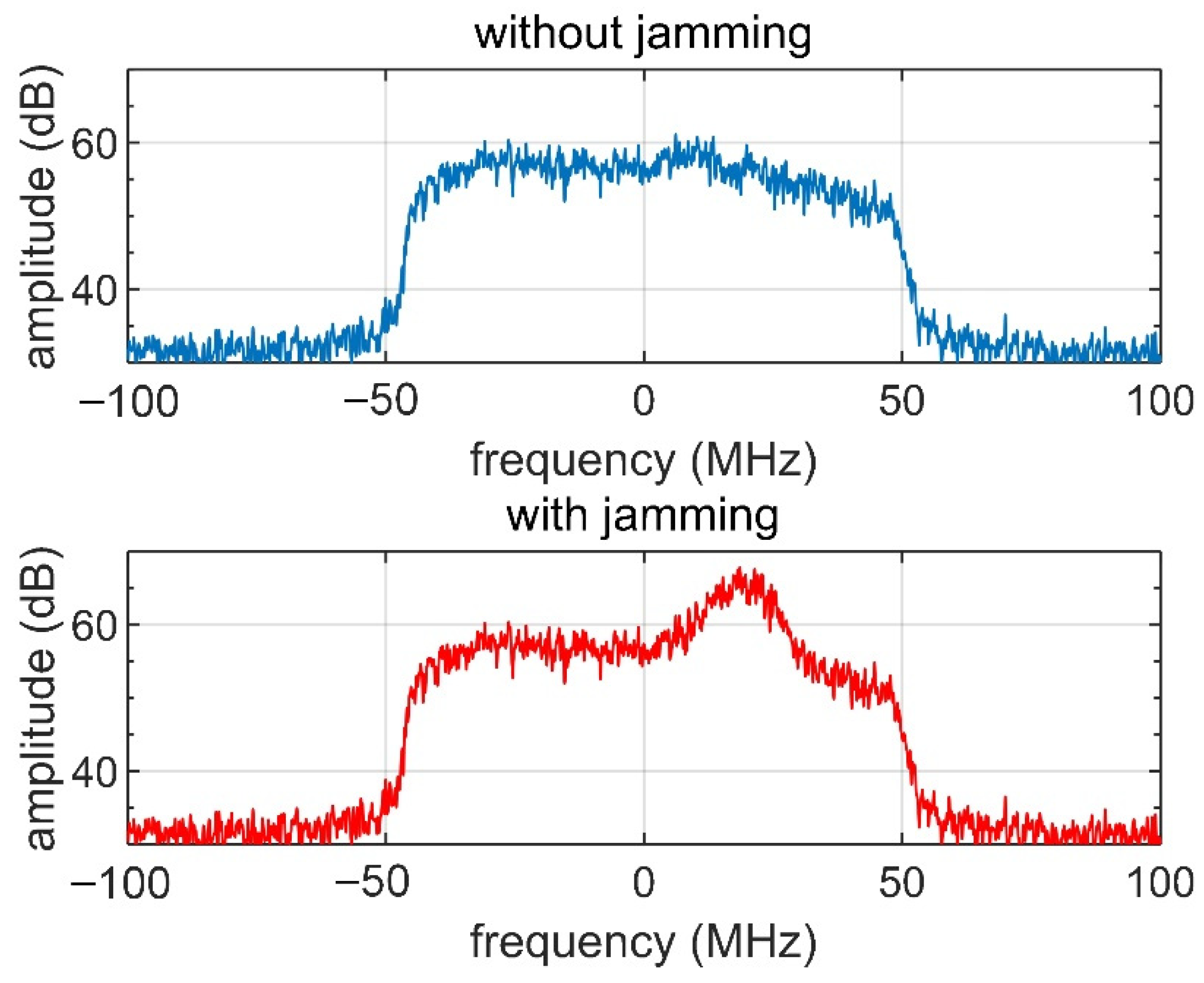
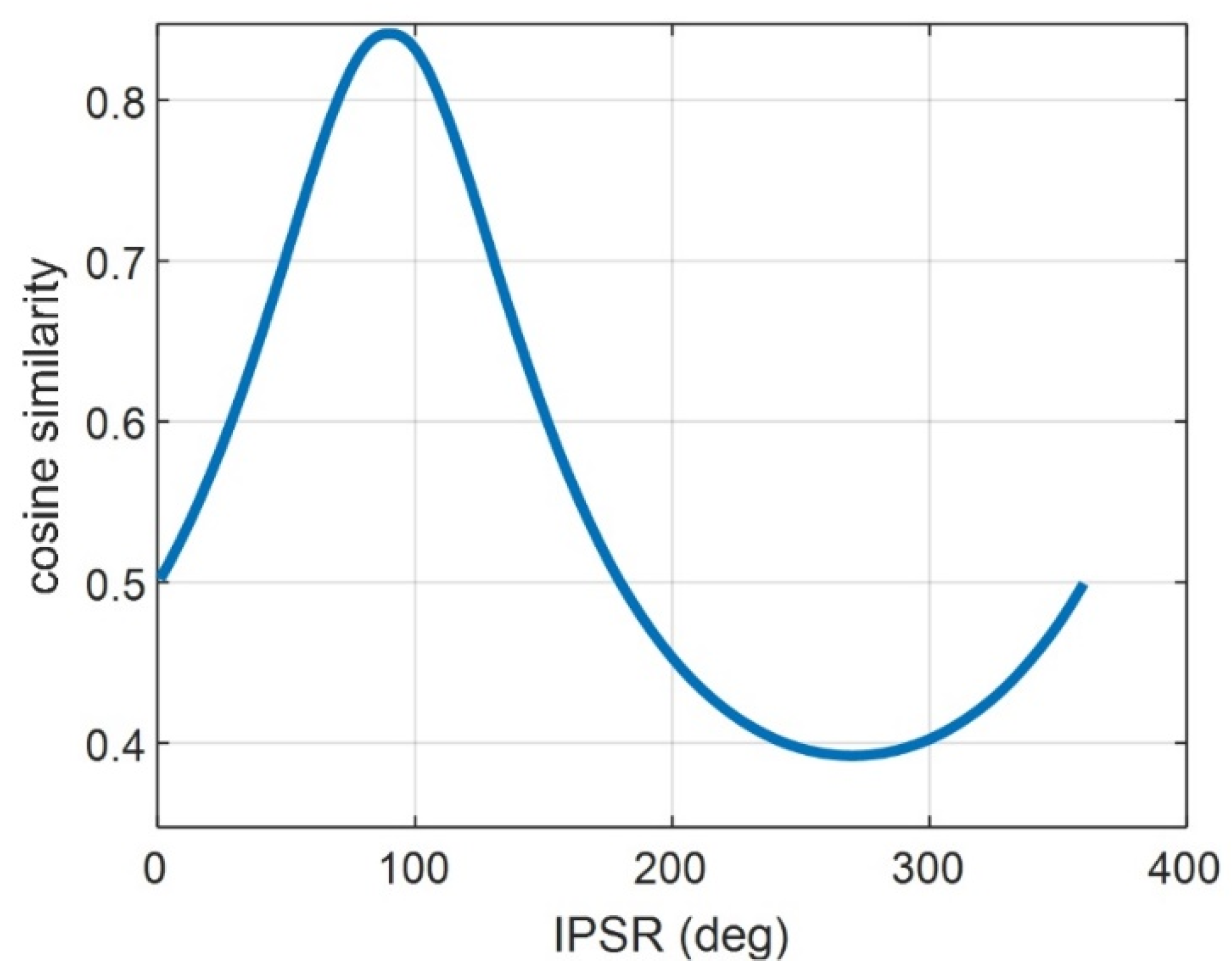




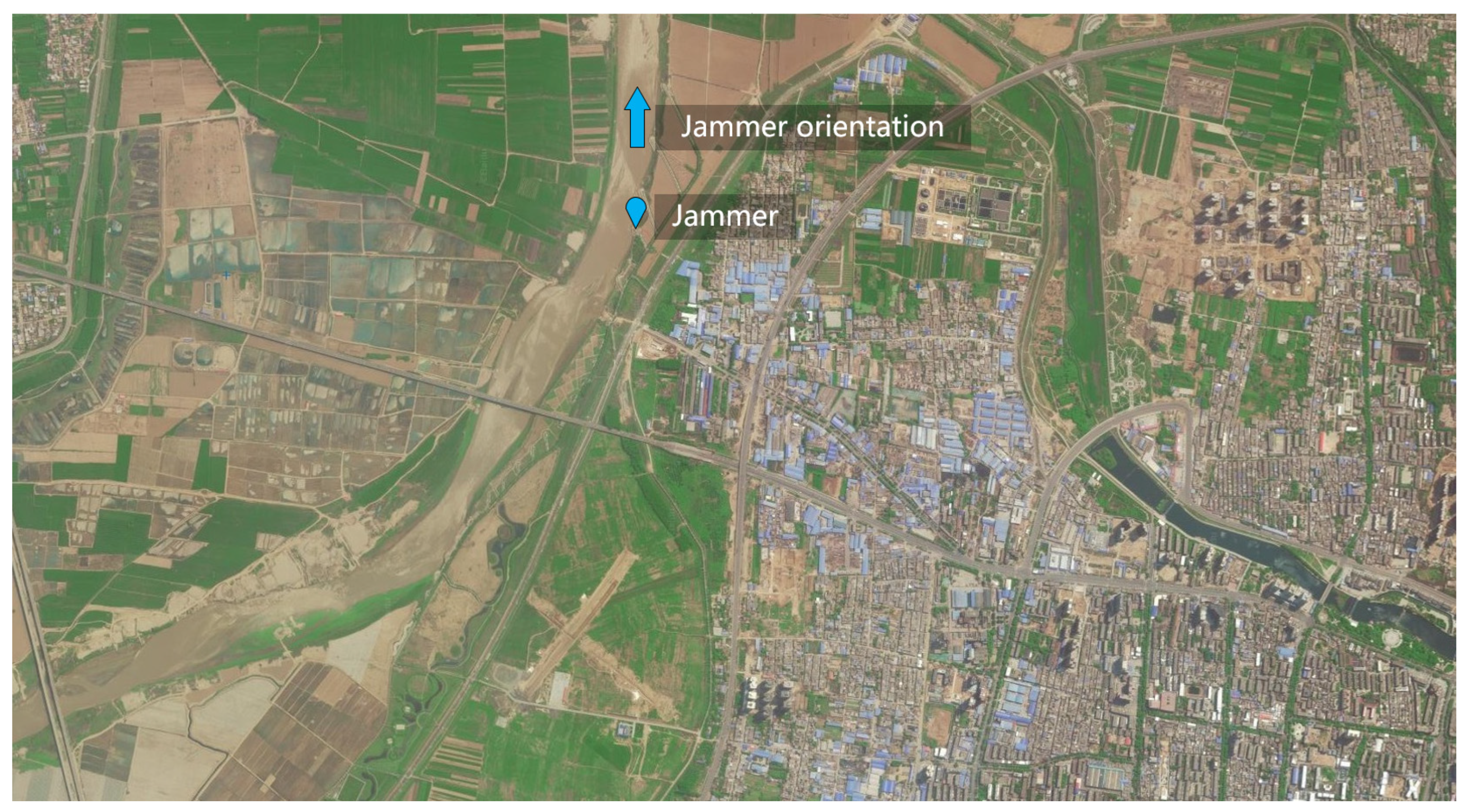
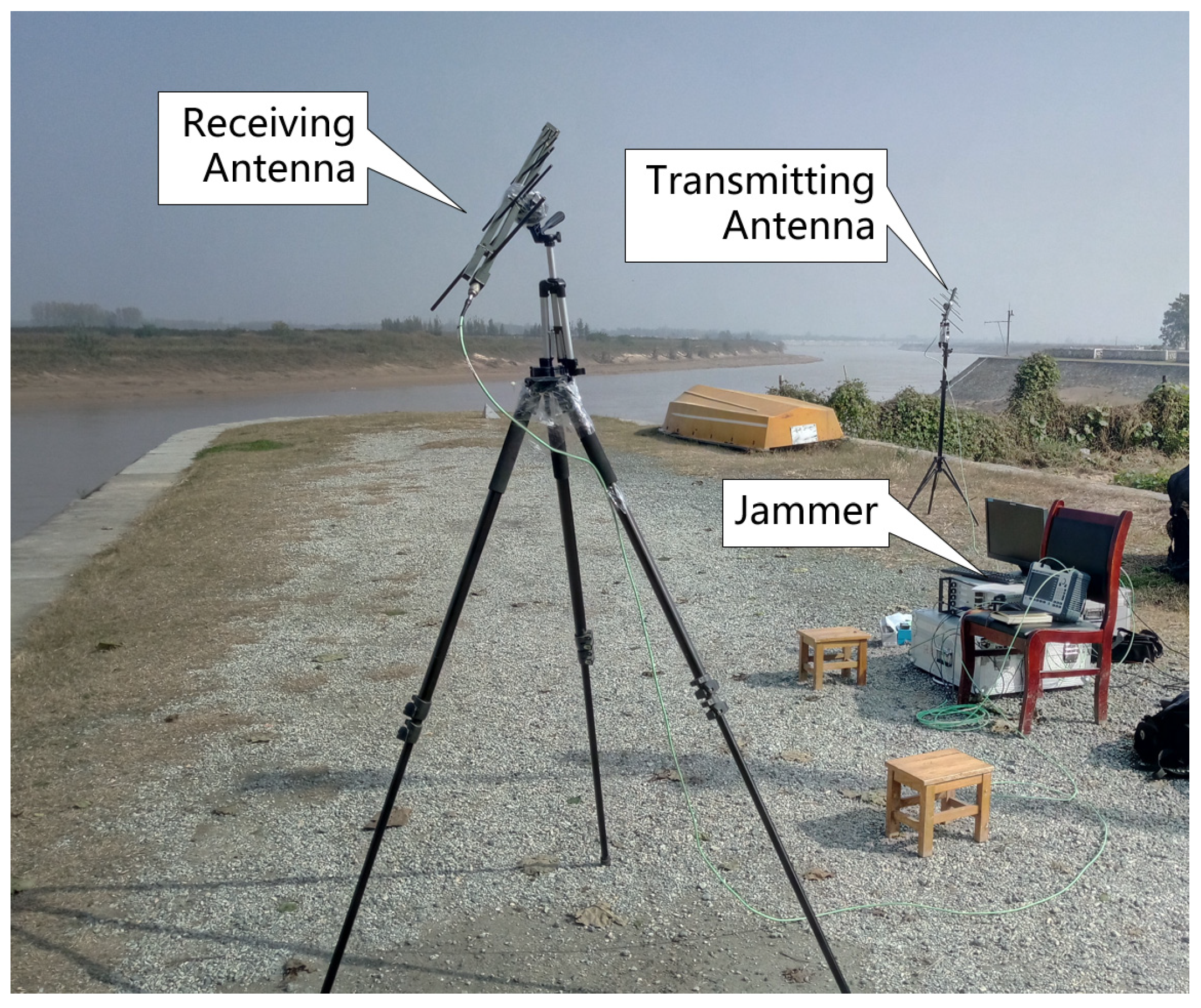

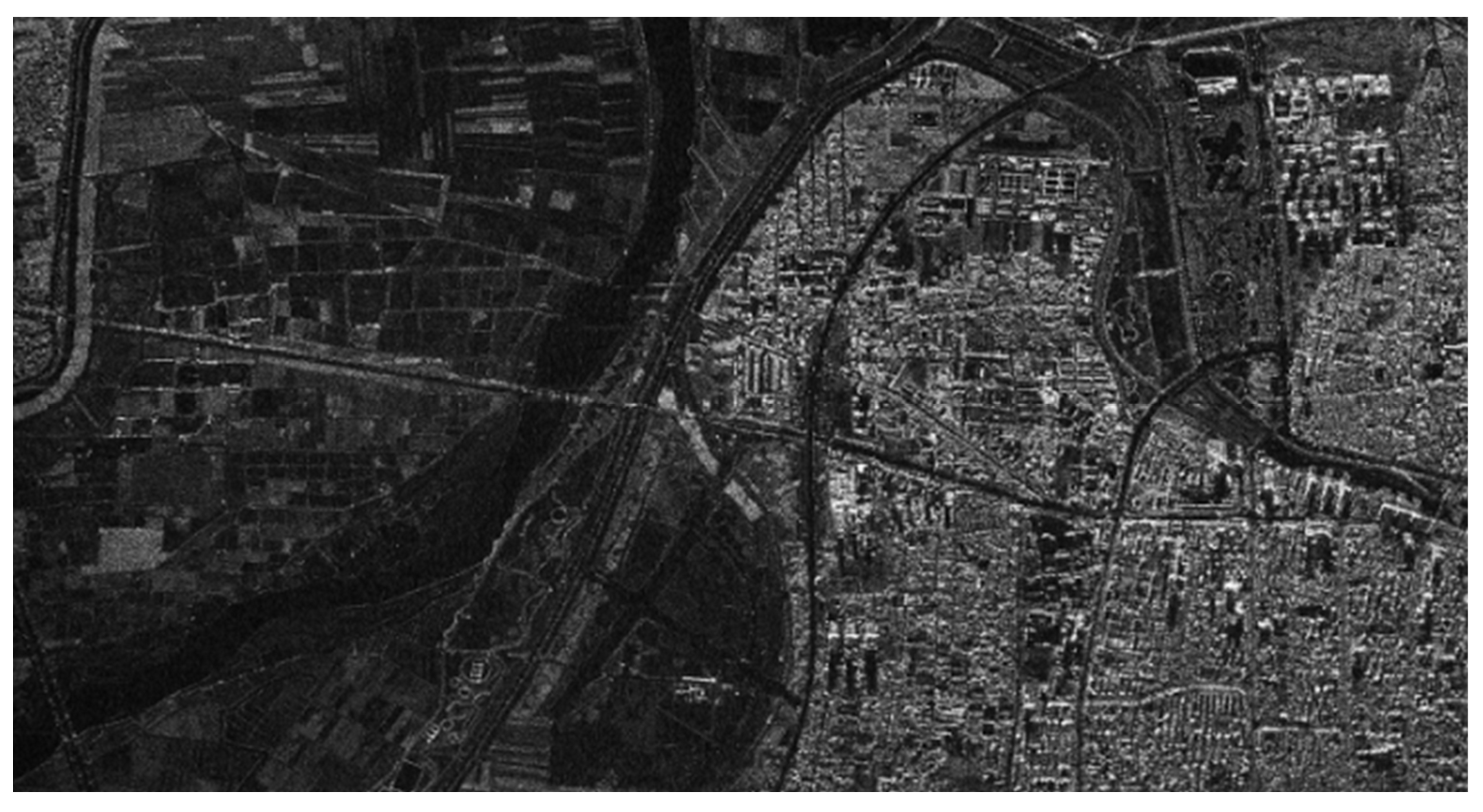
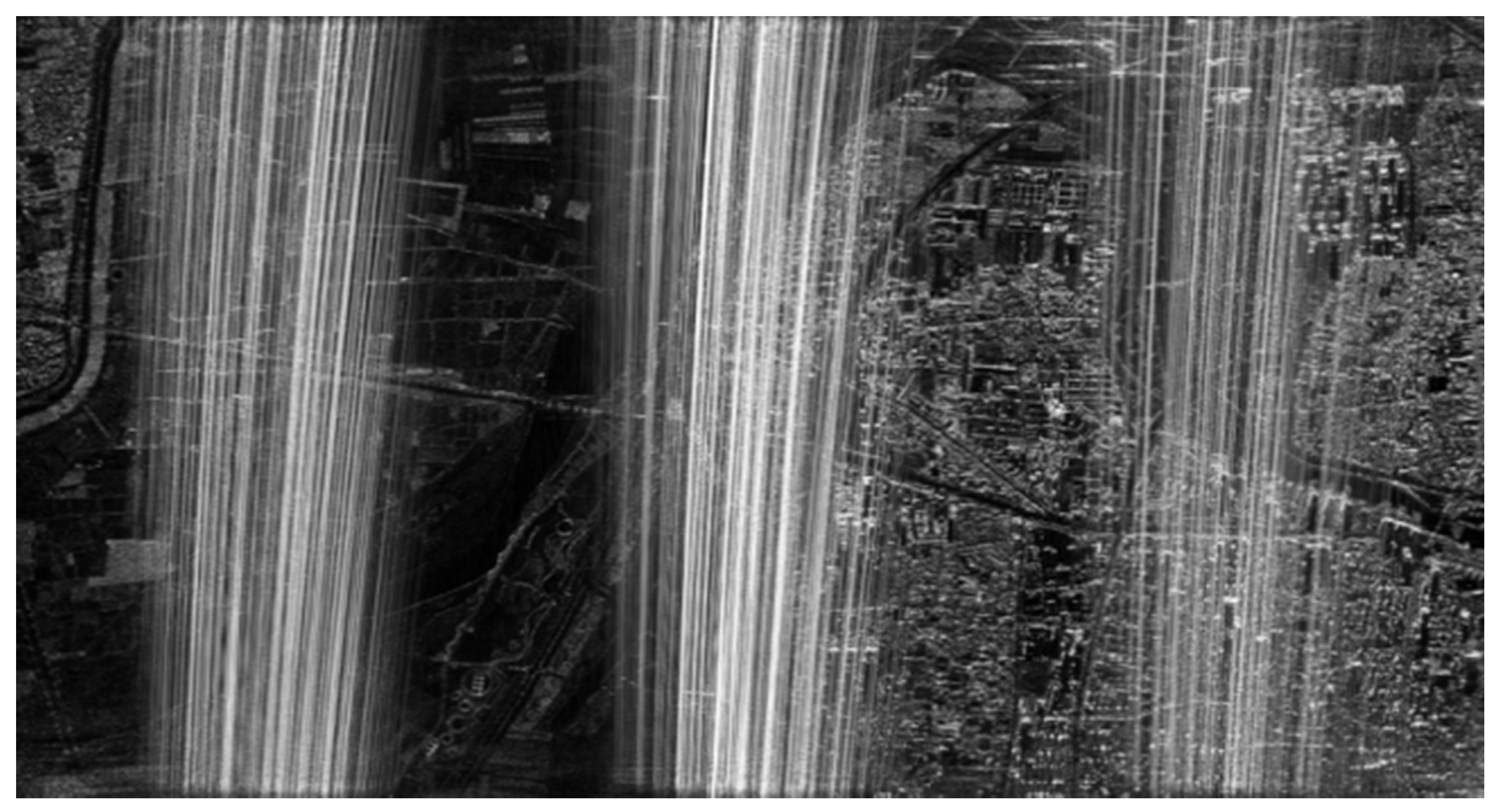


| Operation | Input Data Size | Output Data Size | |
|---|---|---|---|
| Azimuth FFT | |||
| Range points dot product | |||
| Range FFT | |||
| Range points dot product | |||
| Range IFFT | |||
| Azimuth points dot product | |||
| Azimuth IFFT |
| Operation | Input Data Size | Output Data Size | Time Cost (μs) |
|---|---|---|---|
| N times FFT | |||
| N times points dot product |
| Parameter | Value |
|---|---|
| Frequency band | L |
| Bandwidth | 100 MHz |
| Pulse repeat time (PRF) | 800 Hz |
| Noise equivalent sigma zero (NESZ) | <−24 dB |
| Range resolution | 1.5 m |
| Azimuth resolution | 0.6 m |
| Channel number | 2 |
| Channel distance | 0.6 m |
| Typical flight height | 7000 m |
Publisher’s Note: MDPI stays neutral with regard to jurisdictional claims in published maps and institutional affiliations. |
© 2022 by the authors. Licensee MDPI, Basel, Switzerland. This article is an open access article distributed under the terms and conditions of the Creative Commons Attribution (CC BY) license (https://creativecommons.org/licenses/by/4.0/).
Share and Cite
Huang, L.; Liu, A.; Huang, Z.; Xu, H.; Han, D. A Novel Method for Interferometric Phase Estimation in Dual-Channel Cancellation. Sensors 2022, 22, 9356. https://doi.org/10.3390/s22239356
Huang L, Liu A, Huang Z, Xu H, Han D. A Novel Method for Interferometric Phase Estimation in Dual-Channel Cancellation. Sensors. 2022; 22(23):9356. https://doi.org/10.3390/s22239356
Chicago/Turabian StyleHuang, Long, Aifang Liu, Zuzhen Huang, Hui Xu, and Dong Han. 2022. "A Novel Method for Interferometric Phase Estimation in Dual-Channel Cancellation" Sensors 22, no. 23: 9356. https://doi.org/10.3390/s22239356
APA StyleHuang, L., Liu, A., Huang, Z., Xu, H., & Han, D. (2022). A Novel Method for Interferometric Phase Estimation in Dual-Channel Cancellation. Sensors, 22(23), 9356. https://doi.org/10.3390/s22239356








